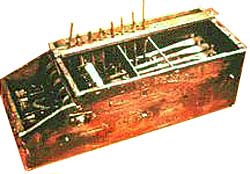
Foto: Smithsonian
Comptometers stamtavla
Family tree of the Comptometer

Foto: Smithsonian
Prototypen / The Macaroni Box
1884-85
Eugene Felts första handbyggda modell stod i många år på hans eget skrivbord som en påminnelse om Comptometerfabrikens blygsamma ursprung. I dag står prototypen på nationalmuseet Smithsonian Institution i USA:s huvudstad Washington.
For years, Eugene Felt kept his original hand-made model on his desk at the Comptometer factory as a reminder of the company's humble beginning. Today the prototype can be seen at the Smithsonian Institution in Washington, D.C.
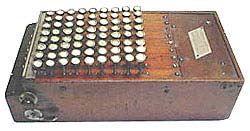
Foto: eBay
Trämodellerna / Wood-cased models
1887-1903
Den första serietillverkade modellen (bilden ovan) hade fodral av trä och tangenter av skrivmaskinstyp. Tangenterna måste tryckas ned en och en, varvid tangenttryckningen registrerades direkt i räkneverket. Vid subtraktion måste komplementtalet fyllas ut med nior.
Den senare modellen (bilden nedan) har dock tangenter av "plast" och är försedda med substopp (varvid komplementtalet inte behövde fyllas ut med nior).
Trämodellen var den första Comptometern med serienummer (SN) från 100 och uppåt. De allra tidigaste exemplaren saknar dock nummer.
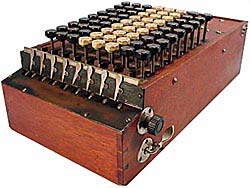
Foto: eBay
The first series of the Comptometer (upper picture) had a wooden case and typewriter-like key tops. The keys had to be depressed one by one, each key-stroke being immediately transferred into the accumulator. Performing subtraction, the operator had to fill up the complement number with nines.
The later model (lower picture) however had composition key-tops as well as a carry inhibitor (dispensing with the need to fill out the complement number with nines).
The "Woodie" was also the first model to carry a serial number (SN), starting count with 100. Very early machines have no serial numbers at all.
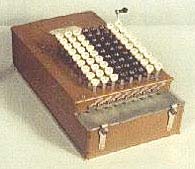
Foto: Okänd
Modell A
1904-06
Modell A var den första Comptometern med kåpa av metall. Liksom de senare trämodellerna är A-modellen utrustad med substopp. Tangenterna är fortfarande åttakantiga och av "plast". Den stora nyheten var emellertid att tangenttryckningen registrerades på återvägen (i stället för vid nedslaget) samt att man nu kunde trycka ned flera tangenter samtidigt, vilket gjorde det praktiskt möjligt att utföra multiplikation och division.
The first steel-cased Comptometer retained the octagonal composition keys as well as the carry inhibitor introduced in the later wooden-cased models. In addition, the 'A' model had an improved mechanism which recorded the key-press on the upstroke and permitted the operator to depress several keys at once, which made it far easier to practise multiplication and division.
SN 15 000-
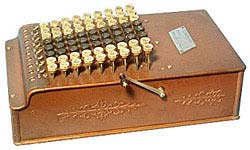
Foto: eBay
Modell B
1906-09
Med modell B hade Comptometer funnit en form som skulle förbli oförändrad i många år. Maskinen var dessutom utrustad med markörer för decimalkomma och betydligt diskretare substopp-spakar.
The 'B' model was built into a new case design which was to remain unaltered for years to come. In addition, it was equipped with decimal pointers and less obtrusive carry inhibitor levers (also called "cut-off tabs").
SN 25 000-
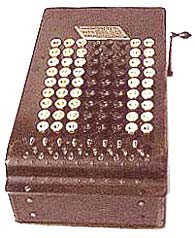
Foto: Okänd
Modell C
1909-13
Modell C är till utseendet väldigt lika modell B. Den uppmärksamme betraktaren noterar emellertid att senare C-modeller (SN 40 000-) har tangenter av celluloid och att kåpan har ett uppseendeväckande stort antal smörjhål.
Having almost the same looks as the 'B,' the later 'C' models (SN 40 000-) are fitted with celluloid key-tops and have an abundant number of oil holes in the case.
SN 35 000-, 40 000-
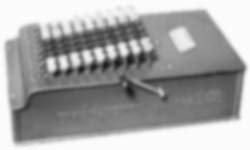
Modell D
19...
Inte mycket är känt om denna udda modell, mer än att endast ett fåtal exemplar hann tillverkas innan serien lades ned.
Not much is known about the elusive model D, but factory records verify that a few examples were actually produced before the series was discontinued.
SN 49 000-
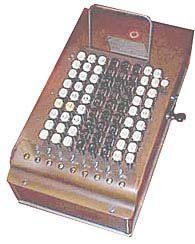
Foto: Okänd
Modell E
1913-15
På modell E infördes en spärranordning som låste tangentbordet vid ofrivillig eller ofullständig inmatning och dymedelst förhindrade förargliga räknefel. Utlösningstangenten syns längst upp till höger på tangentbordet som en ensam vit tangent. Denna sällsynta modell har avlånga tangenter.
The 'E' model introduced the Controlled Key feature which locked the mechanism if a key was depressed carelessly or halfway, invariably leading to calculating errors. The release key is visible as a single white key on the upper right hand of the keyboard. This elusive model has oblong key-tops.
SN 55 000-
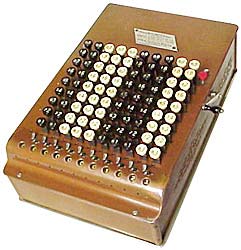
Foto: eBay
Modell F
1915-20
Modell F behöll spärranordningen från modell E - även om utlösningstangenten numera var röd. Tangenterna återtog sin tidigare åttakantiga form.
The 'F' model retained the Controlled Key feature of the 'E,' though the release key now had a red top. The key-tops reassumed the octagonal shape of the earlier models.
SN 100 000-
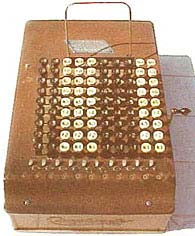
Foto: eBay
Modell H
1920-26
Modell H är den första som pryds av logotypen "Comptometer" på kåpans fram- och baksida. Notera att nollställningsspaken är flyttad framåt, vilket är det synliga tecknet på att denna modell även har fått en ny och förbättrad mekanism.
The 'H' is the first model to sport the large "Comptometer" logotype on the front and back panels of the. Note that the clearing lever is moved forward, which signals that this model also has a new and improved mechanism.
SN 200 000-
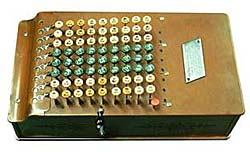
Foto: Christofer Nöring
Modell J
1926-39 (?)
Modell J skils lättast från den snarlika H-modellen på att den har gröna (i stället för svarta) tangenter i kolumnerna för ental, tiotal och hundratal. De vita tangenterna är av en ny sorts plast som tidigt visade en olycklig tendens att murkna och falla sönder.
The 'J' model is most easily distinguished from the 'H' model by its green (instead of black) keys for units, tens and thousands. The white key-tops are made of a new material which soon displayed a characteristic decay - also known as "oozing".
SN 250 000-
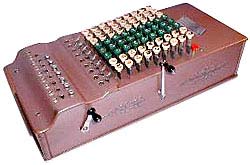
Foto: Okänd
Modell ST
1930-tal
En unik variant av J-modellen var modell ST, även känd som Supertotalisatorn. Maskinen hade separata register för subtotal (delsumma) och total (slutsumma). Antalet tillverkade enheter var dock inte så stort, vilket gör denna modell ganska sällsynt.
This unique variety of the 'J' model was called the Super Totalizer - or 'ST' for short. This superb machine has separate registers for sub-total and grand total. Not many units were built, making the Super Totalizer somewhat of a rarity.
SN 250 000-
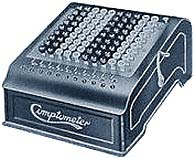
Bild: Annons
Modell K
introd. 1934
Modell K hade elektrisk drift. Nollställningen var dock fortfarande manuell.
The 'K' model had an electric motor. Clearing of the register was still manual.
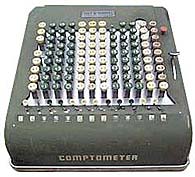
Foto: Ray Mackay
Modell M & WM
1939-57
Och så här såg Comptometer ut på 1940-talet. Inte att undra på att denna fältgröna maskin kallas för krigsmodellen!
And here's how the Comptometer looked in the 1940s. It's not a surprise that this army green machine is called the 'War' model!
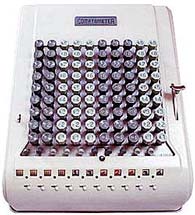
Foto: Museum of HP Calculators
Modell 992, 3 D-11 m.fl.
1957-60
År 1957 bytte Felt & Tarrant namn till "The Comptometer Corporation". Det fanns då både elektriska och mekaniska modeller som denna 3 D-11 med "fjädrande anslag".
In the year 1957, Felt & Tarrant changed its name to "The Comptometer Corporation." The factory line comprised both electrical and mechanical models, one of which was the Model 3 D-11 with "Cushioned Touch".
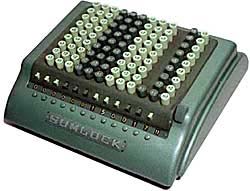
Foto: Nigel Tout
Sumlock Comptometer
1961-73 (?)
1961 uppgick Comptometer Corporation i Victorkoncernen och tillverkningen av comptometrar upphörde - åtminstone i USA. Maskinen fortsatte dock att tillverkas i England av det nybildade bolaget Sumlock Comptometer.
Läs mer om engelska comptometrar på Nigel Touts webbplats.
In 1961, the Comptometer Corporation merged with the Victor Adding Machine Company, and production of Comptometers was discontinued - at least in the United States. Production continued however in Great Britain by the newly-formed Sumlock Comptometer Limited.
Read more about British Comptometers on Nigel Tout's web site.
NOTE: The pictures on this page come from various sources, and some are of unknown origin. If you object to having your picture posted here, please notify me via e-mail.
Thanks to Anna Kraxenberg, Brooke W. Boering and Nigel Tout, who introduced me to the enchanted kingdom of Comptometers!
Tillbaka till Comptometer / Back to the Comptometer